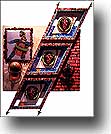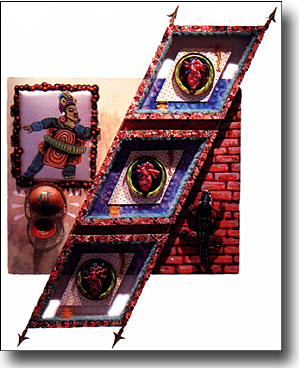Museo de las Artes, Universidad de Guadalajara,
Jan 31, 2002 - Mar 31, 2002
Guadalajara, Jalisco, Mexico
Aesthetic Dissolution? The unique case of the çWe are Oneç duo, where the sum of two thinking brains is greater than one bleeding heart
by Felipe Ehrenberg
Of course those iconoclasts were not the only ones or even the first to question the tyrannical infallibility of an aesthetic that prided itself in incarnating "the spirit of originality." It would be unforgivable to ignore Latin America and its pioneers such as the Venezuelan Reverón (especially in his ante verbum installations), or the Mexican Goitia and his impetuous passion. Both sought to travel down roads as far as possible from the European onesç excuse me, your Honorç no, wait a minute, we’re in the process of summarizing our concluding argument. Courts not unlike this one had to acquit, almost one hundred years ago, certain Mexicans accused of Aesthetic Dissolution because of the names of their movements. Rivera, El Corsito, Covarrubias and quite a few more dared to nurture their works with popular taste (I apologize if anyone feels uncomfortable with this word), including the taste of Indians, God forgive. The plastic artists were not alone. There were musicians such as Moncayo, a contemporary of Villalobos, Bartok and Copeland, who rubbed elbows with people from Potosi and Veracruz and learned from them to take their traditions and create their proposals. May I remind the jury that they were all found innocent because they showed ç and how they showed? ç that not only had they not harmed Art but had changed its direction. Nobody could reproach them for showing their brown-skinned designs, their people from Bahia, their colors and their huapango music in concert halls and galleries, if that is what these venues are there for.
Well, then, ladies and gentlemen, the "We Are One" duo does exactly the same when it presents its magnificent works at a Guadalajara museum. The De La Torre brothers do not look for cheap flatter or provincial approval of this or that critic or chronicler. I can attest that they do it to make their public think, those of us who care that their work reaches us, that it says something to us. After all, isn’t that what this trial is all about?
It was clear to us when they asked us to defend their case that Einar and Jamex were connoisseurs ç as few others are ç of Mexican glassware, from the traditional everyday blown glass from Tlaquepaque, the capriciously shaped glass miniatures sold at fairs, the neo-artisan glassware that transforms Coke and Sprite bottles and redimensions the Simpson family, to the frivolous geometry made in Monterrey to decorate living rooms and offices. If in doubt, you can check the previous minutes where they said: "By the time of the fall of Byzantium in 453, translucent glass had already crossed the Adriatic Sea to stay until the VII century in Ravenna where the luster of ceramic, tiles and mosaics were the delight of strangers and locals." It might also be worthwhile to read the part that says: "This transparent mineral we humans use to illuminate our imagination has not always been welcomed; quite the contraryç" and to compare it with the statements of scandalized reporters, editors of pompous cultural sections, critics ç if there area any left ç and certain officials of the public cultural bureaucracy who anyone can recognize.
|









